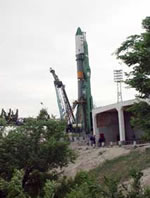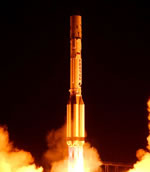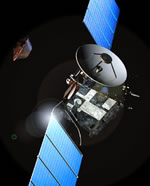NASA’s first Mars Explorer rover roared into space on Tuesday on board a Boeing Delta II rocket after two days of delays to poor weather, and some last minute glitches with ground tracking stations. The newly named rover, “Spirit”, will take seven months to reach Mars. Once it does arrive, the six-wheeled Spirit will land on the surface of the Red Planet, and begin exploring the surface searching for evidence of past water. The second rover, “Opportunity”, was originally expected to launch on June 25, but it might be also be delayed because Spirit’s launch was pushed back.
Foam Test Breaks Shuttle Panel as Expected
As predicted earlier in the week by Columbia accident investigators when a chunk of foam was fired at an actual space shuttle wing, it caused visible and significant damage. The foam was fired from a special pressurized gun at 234 metres per second, and when it struck the wing, it created a 7.5 centimetre crack in the carbon-fiber wing, and damaged several important T-seals. The test wing had actually been flown on space for 30 missions, so the experiment provided useful evidence to support the theory that foam damaged Columbia’s wing so that the shuttle couldn’t survive re-entry.
An initial foam impact test on a section of an orbiter reinforced carbon-carbon left-wing leading edge showed visible and significant damage on RCC panel 6 and the T-seal between RCC panels 6 and 7, the Columbia Accident Investigation Board reported today.
The foam-strike was part of a series of tests the CAIB is conducting at Southwest Research Institute to determine how a foam strike of the kind observed on Columbia’s launch might damage the RCC panels, T-seals, or their support structure. The tests were designed to bracket the observed impact region and conditions.
In today’s outdoor test, investigators fired a large block of foam from a pressurized nitrogen gun aimed at the lower side of left-wing RCC panel 6. The foam struck the panel directly on target and created a three-inch crack extending from a visible three-quarter inch damage area on the outside of the RCC to the RCC rib inside the wing. Later examination revealed that the T-seal between panels 6 and 7 was cracked as well. The strike also caused a shift in the position of RCC panel 6 and the T-seals on either side of that panel, and chipped a carrier panel on the upper side of the wing.
RCC panel 6 was an actual panel that flew 30 missions on Discovery, another Orbiter.
Foam details:
Weight: 1.68 lbs.
Dimensions: 21 3/8 inches x 11 9/16 inches x 5 5/8 inches
Volume: 1,390 cubic inches
Speed: 768 feet per second
Angle of incident: 20 degrees
The CAIB has not reached any final conclusions and has not determined the cause of the loss of the shuttle and crew. The board’s final report will be issued later this summer.
Original Source: CAIB News Release
Progress Launches to Resupply Space Station

Image credit: Energia
An unmanned Russian Progress 11 cargo ship lifted off from the Baikonur Cosmodrome on Sunday, carrying more than two tonnes of food, fuel, water, supplies, and scientific equipment for the International Space Station. The Progress launched at 1043 GMT (6:34am EDT) and then reached orbit nine minutes later. It’s expected to reach the space station on Wednesday, where it will link up automatically with the Pirs Docking Compartment on the Zvezda Service Module.
An unmanned Russian resupply craft successfully blasted off from the Baikonur Cosmodrome in Kazakhstan today, carrying more than two tons of food, fuel, water, supplies and scientific gear for the Expedition 7 crew aboard the International Space Station.
The Progress 11 vehicle lifted off on time from its Central Asia launch pad at 5:34 a.m. Central time (1034 GMT, 2:34 p.m. Baikonur time). Less than nine minutes later the Progress settled into orbit, and moments later, its solar arrays and navigational antennas had been deployed. At the time of the Progress launch, Expedition 7 Commander Yuri Malenchenko and NASA ISS Science Officer Ed Lu were flying near the Equator off the west coast of Africa at an altitude of 240 statute miles.
After three days of pre-programmed engines firings to reach the ISS, the Progress will link up automatically to the Pirs Docking Compartment on the Station?s Zvezda Service Module on Wednesday at 6:17 a.m. Central time (1117 GMT). Within a few hours, Malenchenko and Lu will open the hatch to the ship and begin to unload its cargo.
Stowed in the Progress are replacement parts for environmental systems in both the U.S. and Russian segments of the Station, office supplies, two tanks of potable water, and some clothing items for the two crewmembers. Also aboard the Progress are two experiment kits for European Space Agency cosmonaut Pedro Duque, who will launch in October on the Soyuz TMA-3 vehicle with the Expedition 8 crew for about a week?s worth of scientific research on the ISS under a contract between ESA and the Russian Aviation and Space Agency. Duque will return to Earth with Malenchenko and Lu in the Soyuz TMA-2 vehicle currently docked to the Station.
Original Source: NASA News Release
Watch the Mars Explorer Launch Live
If you’re going to be anywhere near a computer connected to the Internet on Tuesday, why not tune into NASA television and watch the launch of the first Mars Explorer rover. NASA’s set up a fast-loading page that will have operational links when their coverage gets started, so you can tune in.
Coverage begins 1600 GMT (12:00pm EDT). Click here to see the page, and then bookmark it so you can check back tomorrow.
I’ll be watching.
Fraser Cain
Publisher
Universe Today
Proton Launches AMC-9 Satellite

Image credit: ILS
A Russian-built Proton K rocket successfully launched the AMC-9 satellite on Saturday, completing the 300th launch of this rocket design over the course of 38 years. The Proton lifted off from the Baikonur Cosmodrome at 2215 GMT (6:15pm EDT), and the satellite separated from the Breeze M upper stage nearly nine hours later. The AMC-9 will provide digital television, data, and telecommunications services.
A Proton rocket successfully placed the AMC-9 satellite into orbit this morning for Alcatel Space and SES AMERICOM. The launch was conducted by the U.S.-Russian joint venture International Launch Services (ILS).
This marks the 300th flight of a Proton vehicle, including 38 years of Russian federal missions and seven years with commercial flights under the auspices of ILS. Today?s mission was the first Proton rocket launch of the year for ILS.
The vehicle used today was Proton vehicle with a Breeze M upper stage, which lifted off from the Baikonur Cosmodrome at 4:15 a.m. local time (22:15 June 6 GMT, 6:15 p.m. June 6 EDT). After 8 hours and 55 minutes, the AMC-9 satellite was separated from the Breeze M and placed into geostationary transfer orbit. Satellite builder Alcatel Space of Cannes, France, contracted for the launch as a delivery-in-orbit mission.
?Once again, Proton demonstrated that it is one of the most reliable vehicles in the world,? ILS President Mark Albrecht said. ?It?s a pleasure to provide both Alcatel Space and SES AMERICOM with another excellent launch.?
?I am delighted about the launch of AMC-9, a satellite that is important to our plans for growth of the AMC fleet,? said Dean Olmstead, president and CEO of SES AMERICOM. ?I extend warm congratulations to the entire team on the occasion of this picture-perfect launch and achieving the great 300th Proton mission milestone.?
This also was ILS? 14th launch of a satellite for a member of the SES GLOBAL family of companies ? SES AMERICOM and its predecessor GE AMERICOM, SES ASTRA and AsiaSat. In addition, ILS is scheduled to launch three more AMC satellites on either Proton or Atlas rockets in the 2003-04 time frame, and has recently acquired a fourth, not yet identified AMC mission.
This also is the eighth Alcatel Space-built satellite launched by ILS. AMC-9 is a Spacebus 3000B3 model with 48 transponders. It will enable SES AMERICOM, an SES GLOBAL company, to expand its digital television broadcasting, data transmission and telecommunication service offerings to North America.
ILS is a joint venture of Lockheed Martin Corp. (NYSE:LMT) in the United States, which builds the Atlas rocket; and Russian companies Khrunichev State Research and Production Space Center and RSC Energia. Khrunichev produces the Proton vehicles and the Breeze M upper stage.
ILS was formed in 1995 to provide launch services to customers worldwide, including technical, management and marketing expertise. It offers the broadest range of launch services in the world along with the highest reliability in the industry.
Original Source: ILS News Release
Bad Weather Pushed Back Mars Explorer
The launch of NASA’s Mars Explorer spacecraft was pushed back to Tuesday because of bad weather at the Cape Canaveral, Florida launch pad. The spacecraft was originally supposed to lift off on Sunday, but storms forced the controllers to delay the launch, and then again on Monday. If the weather behaves, Explorer will lift off at 1758 GMT (1:58 pm EDT) and carry the newly named rover “Spirit” towards Mars. The second rover, “Opportunity” will follow on June 25.
Mars Environment Changes More than Previously Thought

Image credit: NASA
A year’s worth of observations from the Mars Odyssey spacecraft is starting to overturn some older theories about how environmentally active the Red Planet is. Using Odyssey’s Thermal Emission Imaging System (THEMIS), scientists were able to detect geological formations of lava and rock which were deposited under varying environmental condition. One example is kilometre wide sheets of bedrock which are being scoured bare by wind. If Mars were less active, they should be covered in sand and dust.
The first overview analysis of a year’s worth of high-resolution infrared data gathered by the Thermal Emission Imaging System (THEMIS) on NASA’s Mars Odyssey spacecraft is opening Mars to a new kind of detailed geological analysis and revealing a dynamic planet that has experienced dramatic environmental change.
The report by THEMIS’s science team will appear in an upcoming issue of Science and will be released on June 5 in the magazine’s online preview, Science Express.
“THEMIS is creating a set of data that is going to revolutionize our mapping of the planet and our idea of the planet’s geology,” said lead author and THEMIS Principal Investigator Philip Christensen, Korrick Professor of Geological Sciences at Arizona State University. “It will keep Mars scientists busy for the next 20 years trying to understand the processes that have produced this landscape.”
THEMIS is providing planetary geologists with detailed temperature and infrared radiation images of the martian surface. The images reveal geological details that were impossible to detect even with the high-resolution Mars Orbital Camera on NASA’s Mars Global Surveyor and that have 300 times higher resolution than MGS’s Thermal Emission Spectrometer. Among the significant findings noted in the report is the detection of layers in the martian surface that indicate major changes in past environmental conditions.
“With a visible light camera, I can take a picture of a lava flow, but even with the highest resolution cameras that we have today the smallest thing we can see is the size of a bus and in order to do geology I need to have more detail,” said Christensen.
“The camera on Mars Global Surveyor takes exquisite images that show layers, but it doesn’t tell me anything about composition – is it a layer of boulders with a layer of sand on top? I have no way of knowing. With the THEMIS temperature data, I can actually get an idea because the layers vary – and each layer has remarkably different physical properties.”
Daytime and nighttime temperature data can allow scientists to distinguish between solid rock and a variety of loose materials, from boulders to sand and dust. As any beach-goer knows, fine-grained sand heats up more rapidly at the surface than solid stone (which transmits more heat inward) but it also cools off more rapidly at night, when solid materials retain heat.
“We have seen layers, each with dramatically different physical properties, in places like Terra Meridiani,” Christensen said. “Why do the physical properties in the different layers change? They change because the environment in which those rocks were deposited changed.
“It’s very difficult to say exactly what happened in any particular place, but what we’ve found is that in many places on Mars it hasn’t just been the same old thing happening for year after year for billions of years. These data have been so remarkable and so different from all of our previous experience that it has taken time to sift through the images and figure out what we’re seeing.”
Among the details that have stood out so far are kilometer-wide stretches of bare bedrock that Christensen notes were unexpected, given the Mars’ known dustiness. Large areas of exposed rock indicate that strong environmental forces are currently at work, “scouring” from the surface any past sediment as well as any new material that might be falling from the atmosphere.
Also unexpected is the finding that accumulations of loose rock are common on martian hillsides, indicating recent processes of weathering continuing to affect the planet. ” If those rocks had been made a billion years ago, they’d be covered with dust,” Christensen pointed out. “This shows a dynamic Mars – it’s an active place.”
However, despite Odyssey’s past findings of significant martian ice deposits, there are also indications that, in many places on the planet, water may not be one of the active causes behind the observed geological features.
Analyzing the spectra from the ten different bands of infrared light the instrument can detect, the THEMIS team has begun to identify specific mineral deposits, including a significant layer of the mineral olivine near the bottom of a four-and-a-half kilometer deep canyon known as Ganges Chasma. Olivine, Christensen notes, is significant because it decomposes rapidly in the presence of water.
“This gives us an interesting perspective of water on Mars,” he said. “There can’t have been much water – ever — in this place. If there was groundwater present when it was deep within the surface, the olivine would have disappeared. And since the canyon has opened up, if there had ever been water at the surface it would be gone too. This is a very dry place, because it’s been exposed for hundreds of millions of years. We know that some places on Mars have water, but here we see that some really don’t.”
Overall, Christensen notes that the emerging diversity and complexity of the planet point to the likelihood of future surprises and keep enlarging the possibilities for discovery on Mars.
“With Odyssey, we are looking at Mars in its entirety, in context. It’s remarkable how much this has already changed our view of the complexity and richness of the planet. We discovered that it has a really dynamic geologic history. It has far more ice and water than we thought — we’re seeing snow and gullies, layers – and there are also processes involving volcanoes, impact craters and wind. It’s a fascinating place.”
Original Source: NASA News Release
Earth Could Have Formed Quickly
Our Earth might have formed a lot earlier that astronomers previously believed, maybe as quickly as 10 million years after the birth of the Sun. In fact, all of the inner planets might have started forming as soon as 10,000 years after the Sun ignited 4.5 billion years ago. Within 10 million years, the Earth had reached 64 percent of its mass, and later collided with a Mars-sized object to provide additional mass and create the Moon. Scientists originally believed that the Earth took 50 million years to form.
Book Review: The Universe 365 Days

If you’ve spent some time on the Internet, you’ve come across the Astronomy Picture of the Day (APoD) website, run by astrophysicists Robert Nemiroff and Jerry Bonnell. Once a day they post up a space-related picture, provide a handy description. I’ve said to myself on several occasions, that these guys should write a book. Well, now they have.
The Universe: 365 Days ($20.97 from Amazon.com) is a print version of APoD, and it’s one of the most gorgeous astronomy books I’ve ever seen. Open it up to any page: on your right is a full-page photograph, and on your left is a paragraph description about the picture. That’s it, 365 pages of description/picture, rinse, repeat. Not much else to say. If you like pictures of space and astronomy, then you’re going love it, page after page.
Because there are so many photographs, the authors were able to draw from a large pool of images. So, it isn’t just the same old NASA/Hubble pictures that everyone uses, there are some from more obscure observatories and even amateur astronomers. There’s a handy index at the back so you seek out images by topic.
I understand why they decided to go with the whole 365 days concept; it’s a connection to their website. But then, it’s not like you’re going to read the book one day at a time, like some kind of yearlong astronomical advent calendar.
Let me just stick my drooling tongue back in my mouth for a second and let you know my complaints with the book. First, the text is really small. Unreasonably small considering that it’s swimming in white space. The layout person should have been thinking about all the people who might be reading this book, and steered well away from 9 point font. My other complaint is that it feels fragile. Imagine you’re holding a stack of nearly 400 photographs bound together on the left-hand side. I’m worried that it might come apart with all the use it’ll get sitting on a coffee table. I’m afraid to let Chloe look through it, as she’ll render it into pulp in minutes.
Still, complaints aside The Universe: 365 Days is a fantastic book. Gorgeous photographs put into context by scientists who’ve had years of experience boiling complex concepts into handy, bite-sized write-ups. Hey, that’s what I do?
Mars Express Passes Another Crucial Stage

Image credit: ESA
Europe’s mission to Mars continues with the next crucial step of Mars Express’ journey out of the way. The clamps holding Beagle 2 tightly during launch were released over the course of 30 minutes on Thursday morning. If this phase had malfunctioned, Mars Express wouldn’t have been able to release Beagle 2 when they reached Mars, ending the mission before it had begun. The spacecraft is expected to arrive at Mars in late December.
Europe’s first mission to the Red Planet, continues its successful mission with another successful ‘high-risk’ post-launch milestone. Mars Express engineers breathed a sigh of relief this morning at the European Space Operations Centre (ESOC), in Germany.
If a particularly delicate operation had not proceeded as planned, it would have been impossible to deploy the Mars Express lander, Beagle 2, on arrival at Mars.
This crucial operation consisted of releasing Beagle-2’s launch clamps. These clamps are extra attachments that ensure the lander stays perfectly fixed to the spacecraft during the launch and is not affected by launch vibrations. After the launch, these clamps are no longer needed, since another mechanism keeps Beagle 2 in place during the six-month trip to the Red Planet.
This second mechanism allows Mars Express to deploy Beagle 2 on arrival at Mars. However, if the launch clamps had not released today, the second mechanism would have failed. “The Beagle-2 mission would have been over before it had even started!” commented ESA Lander Manager, Con McCarthy.
The release of the launch clamps started at 10.10 CEST and lasted about 30 minutes. The release mechanism itself is unusual. Usually, launch clamps contain a firework-like mechanism, but Mars Express had a much gentler release mechanism for Beagle. It consisted of a sleeve over a clamp bolt; an electric current heats the sleeve to about 100?C. At that temperature, the sleeve expands and the bolt snaps. There were three bolts and they all broke in sequence.
“We had to wait two minutes for the expansion of the sleeve which snapped the bolt. The atmosphere in the room was tense and those two minutes seemed to last an eternity! When the first bolt went, a lot of tension was released,” says McCarthy.
There are more hurdles ahead but Mars Express is demonstrating that it can deal with the many challenges on the way to the Red Planet.
Original Source: ESA News Release
